 This weekend, I was having lunch with friends and they recommended a movie they had seen at the Locarno Film Festival earlier in the summer. I came home and looked it up, only to discover that there were no plans for the film to be released theatrically in the UK.
This weekend, I was having lunch with friends and they recommended a movie they had seen at the Locarno Film Festival earlier in the summer. I came home and looked it up, only to discover that there were no plans for the film to be released theatrically in the UK.
I have previously studied how many Cannes-nominated films reached UK cinemas and found it to be quite high (84% of movies nominated in 2015). This got me thinking: how representative of the festival circuit is Cannes?
Cannes is probably the best-known and most prestigious festival in the world, so we would expect that more of their nominated movies get a full release than films at other festivals. But by how much? Let’s take a look.
How many festival films reach cinemas?
I focused on the past twenty years and gathered data on all films nominated for the major film award at the following festivals:
- Sundance Film Festival
- Berlin International Film Festival
- Cannes Film Festival
- Locarno Festival
- Venice Film Festival
I then looked to see how many of those films (3,342 in total) received a theatrical release in any country. I chose to look at films in festivals between 1998 and 2017 as that gives even the most recent films over a year to have announced their release dates.
We’ll start by looking at US distribution. Over half of Sundance and Cannes-nominated films reach US cinemas, with Venice and Berlin nominees not far behind. Locarno films are less successful, with fewer than one in five making it to the big screen in America.
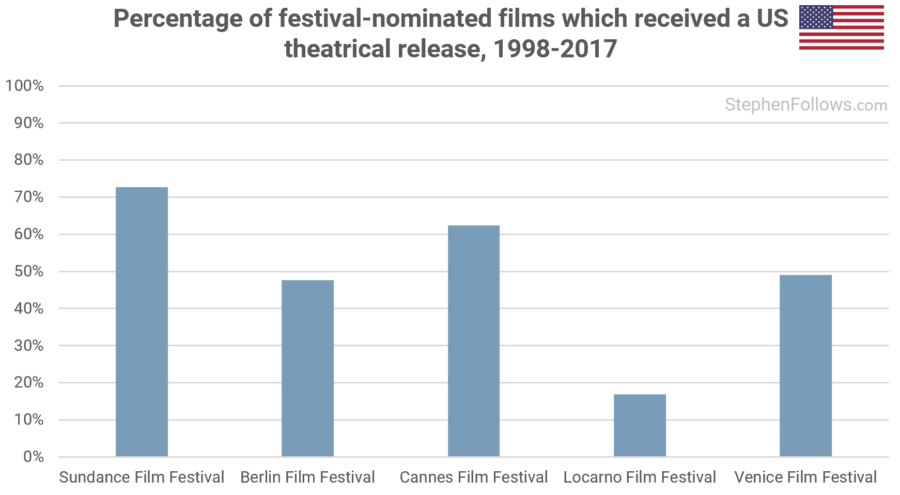
In the UK, Cannes films are more successful, but Sundance films are much less so. Locarno still languishes below one in five.
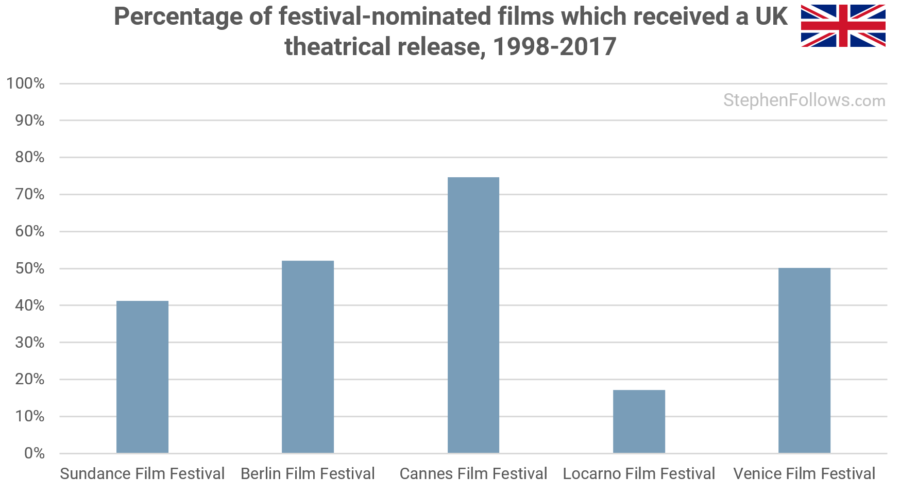
How widely distributed are festival-nominated movies?
Let’s look further afield than just the US and UK. I gathered release dates in every country I could for each movie. This shows a few things.
Firstly, distribution has been getting wider over time. In 1998, the average Cannes-nominated film reached cinemas in 14 countries. By 2017, this had doubled to an average of 28 countries.
Secondly, Cannes is indeed the highest performing festival. Films nominated at Cannes have a much better track record of theatrical distribution compared to the other festivals I studied.
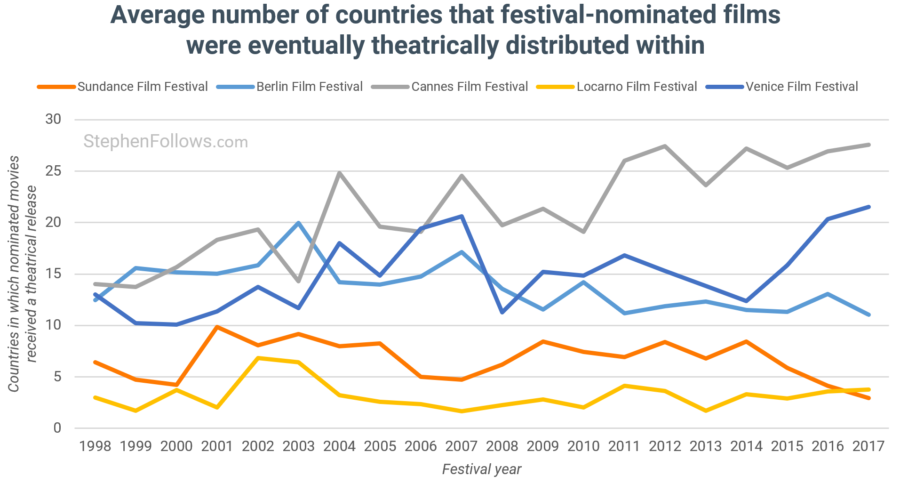
Does a film’s quality affect its chances of post-festival theatrical distribution?
So far, it’s not looking good for me seeing my friend’s Locarno recommendation.
But the fact that he liked it could mean that it was one of the best films at this year’s festival. And if so, would it have a higher than average chance of making it to cinema screens?
To measure this, I looked at the correlation between the number of countries each film was distributed in and their ratings – both with film critics and with film audiences.
Let’s start with film critics, which I tracked using the Metascore, which is an average of all major critics’ scores. The correlation is displayed by calculating the Pearson correlation coefficient measure. A score of zero would mean there was no connection in any way between the number of countries a film is screened in and their Metascore. A score of one would mean that it was absolutely positively correlated, meaning that when Metascores go up, the distribution gets wider.
Sundance films have the highest Pearson scores, meaning that the best films at Sundance have a higher chance of wide distribution compared with the other four festivals in my study. Locarno is at the bottom, with a score of under 0.2, which is not generally regarded as statistically significant.
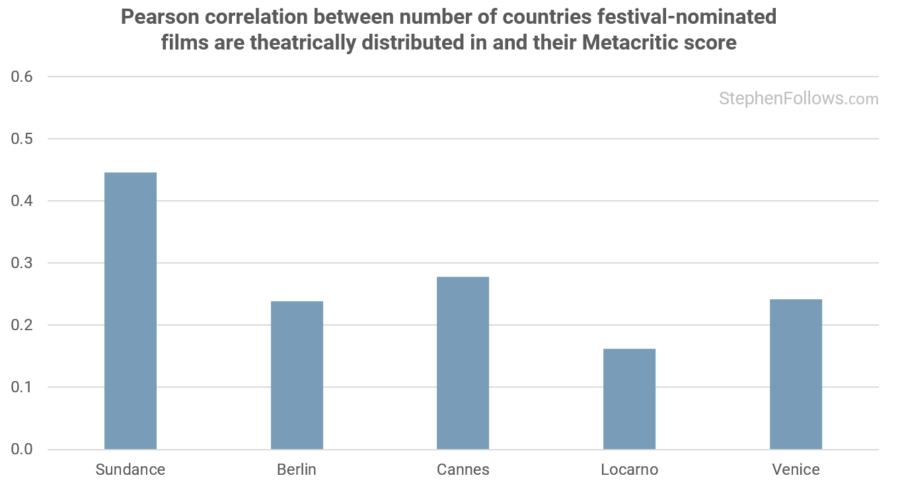
If we move away from film critics and look at what the audience thinks (as measured by IMDb user scores) we see a stronger correlation… in all festivals but Locarno.
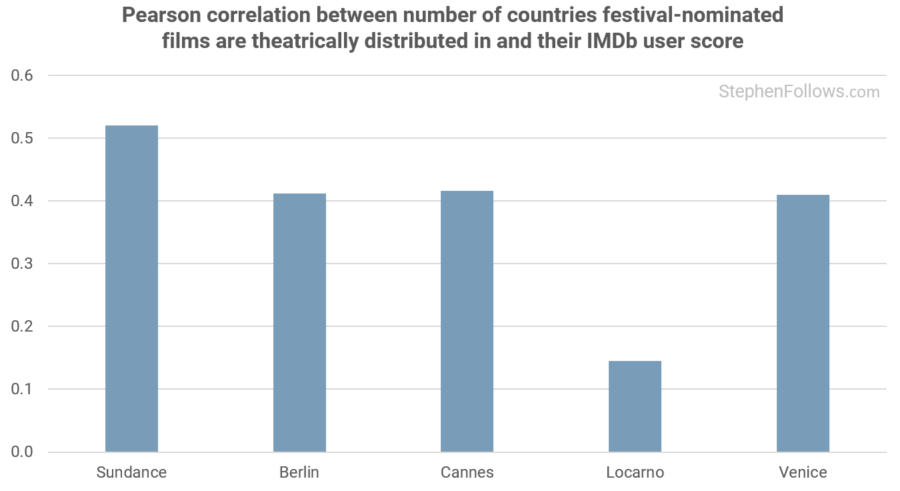
Damn. It looks like my chances of seeing the Locarno pick on the big screen are not great. Ah well, at least I got to make some graphs out of the possibility.
Further reading
Last year, I looked at how many Cannes-nominated films reach UK and US cinemas, how long they take to reach the big screen and why. You can read that piece here: How many Cannes-nominated films get a theatrical release?
Notes
This is a study of films nominated for the main award at each festival and therefore does not include films in sidebar or ‘Out of Competition’ programming. Those major awards are:
- Sundance: “Grand Jury Prize” – In this study, I only looked at those in the dramatic competition, not documentary.
- Berlin: “Golden Bear”
- Cannes: “Palme d’Or”
- Locarno: “Golden Leopard”
- Venice: “Golden Lion”
Epilogue
I’m grateful to Roberto and his family for inspiring today’s research topic. And to other people who are considering inviting me to lunch, be warned – graphs will follow!

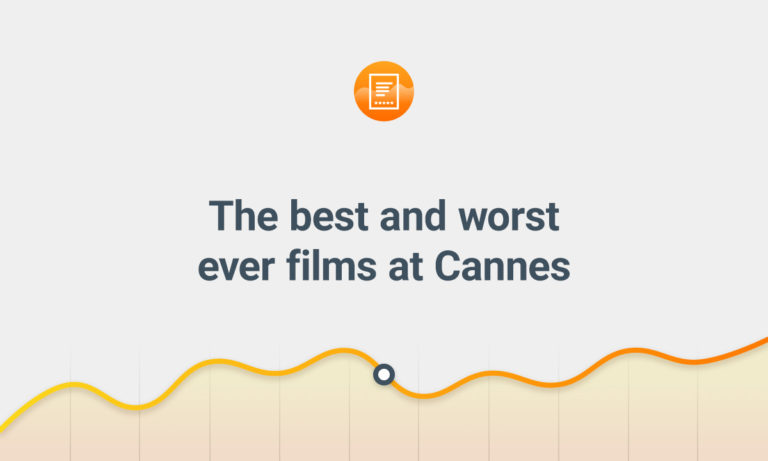



Comments
Which Film was it?:)
Ha-ha. I know that it’s conspicuously absent, but I try to avoid plugging or chastising individual films. Just the facts, ma’am. Sorry….
Hi Stephen! It’s Carolyn from Canada – we met in Winnipeg in January. Great insights – just wondering why TIFF wasn’t included 🙂 Thanks!
Because they don’t have a competitive prize in the traditional sense.
They have one now, the PLATFORM section
https://www.indiewire.com/2018/05/tiff-2018-platform-jury-1201962302/
Ah great! I’ll include that in future research. That’s for pointing it out.
Hi Stephen
I understand that you didn’t include TIFF because it doesn’t have an official competition. But in North America at least its people’s choice award, voted by public audiences, is thought to be a strong predictor of Oscar bait, which in turn requires commercial release. So it might be worthwhile to include TIFF.
And it may not be equitable to include Locarno in this group, since it tends to select mostly European & edgier art films, which have a much slimmer commercial opportunity. Sundance of course will dominate as it’s primarily US films.
Love your graphs!
Hi Kay
I agree on both points. I looked at TIFF a few years ago https://stephenfollows.com/costs-income-films-toronto-international-film-festival/
Hello Stephen. Have you explored genre film festivals? Like Fantastic Fest, Frightfest, Screamfest, After Dark Film Festival, and Fantasia.
Yes, I have for horror festivals in my Horror Report https://stephenfollows.com/horrorreport/
Ok here,
Sundance it’s been pushed over by Hollywood 3rtg patries to gain markets but does it only well within the us, in fact , in Europe or other parts of the world nobody really cares about Sundance, yes, if you look it from an American point of view might hurt your feelings, you won’t see it that way cose pride, your flag, your country, but in an Art cinematic point of view Sundance equals to Wallmart.
Sorry
Thanks for the – as always – fascinating research, Stephen! If I understand correctly you only analyzed the Sundance prize for US films, right? I wonder how the data would change if the “World Cinema Jury Prize: Dramatic” would be added. It was only created in 2005, so it wouldn’t apply for the first few years you analyze, but I’m guessing the number of Sundance winners to get an American theatrical release would go down and put it more in line with other international festivals with regards to theatrical release in the US. Those other film festivals are truly international in a way that Sundance (particularly in its early years) is not.
Awesome research. Will you factor in Toronto or Canadian Festivals at some point? I’ve heard it is also a major festival.
Would be possible to do the research on selected films in competition to European A-film festivals based on first country of production? In other words, to see statistic how much European A-film festival are open to selecting European films (or non-European films), and which countries of production are the most common to appear at these film festival (Berlin, Cannes, Locarno, Venice, etc) in competition section?
Yup! Here are a few:
Hope that helps!